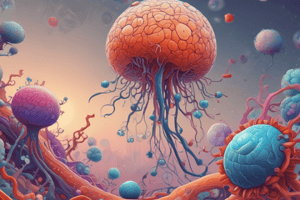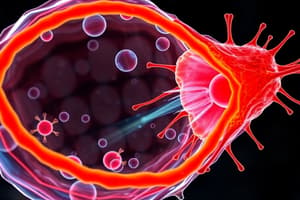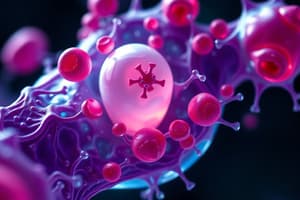Podcast
Questions and Answers
What role does chlorophyll play in a chloroplast?
What role does chlorophyll play in a chloroplast?
- It reinforces the structure of the chloroplast.
- It aids in the conversion of solar energy into chemical energy. (correct)
- It serves as a receptor for cell communication.
- It absorbs water to support plant hydration.
Which characteristic of the cell membrane contributes to its selective permeability?
Which characteristic of the cell membrane contributes to its selective permeability?
- The arrangement of hydrophobic and hydrophilic regions in phospholipids. (correct)
- The presence of ribosomes on the membrane surface.
- The rigidity of the membrane due to thylakoids.
- The strength of the cellulose fibers within the membrane.
What is a primary function of the cytoskeleton in a cell?
What is a primary function of the cytoskeleton in a cell?
- It maintains the plant cell's rigid structure.
- It facilitates communication between cells.
- It provides structural support and allows for mobility. (correct)
- It stores chlorophyll for photosynthesis.
How does the cell wall contribute to a plant cell's overall function?
How does the cell wall contribute to a plant cell's overall function?
What distinguishes chloroplasts from other organelles in plant cells?
What distinguishes chloroplasts from other organelles in plant cells?
What is the primary role of lysosomes during the endocytosis process?
What is the primary role of lysosomes during the endocytosis process?
Which of the following correctly describes exocytosis?
Which of the following correctly describes exocytosis?
During endocytosis, what happens to the formed vesicle after it surrounds a large particle?
During endocytosis, what happens to the formed vesicle after it surrounds a large particle?
What initiates the process of exocytosis within a cell?
What initiates the process of exocytosis within a cell?
Which statement about both endocytosis and exocytosis is true?
Which statement about both endocytosis and exocytosis is true?
What is the primary role of a receptor in cellular communication?
What is the primary role of a receptor in cellular communication?
Which statement accurately describes membrane receptors?
Which statement accurately describes membrane receptors?
Which type of molecules are intracellular receptors most likely to bind?
Which type of molecules are intracellular receptors most likely to bind?
What distinguishes passive transport from active transport in cellular processes?
What distinguishes passive transport from active transport in cellular processes?
What process is defined as the movement of water across a selectively permeable membrane?
What process is defined as the movement of water across a selectively permeable membrane?
What describes the movement of water in osmosis?
What describes the movement of water in osmosis?
Which statement about active transport is true?
Which statement about active transport is true?
What will happen to a cell placed in a hypertonic solution?
What will happen to a cell placed in a hypertonic solution?
Which of the following mechanisms does not require energy for molecule transport?
Which of the following mechanisms does not require energy for molecule transport?
What is the primary purpose of endocytosis in cell transport?
What is the primary purpose of endocytosis in cell transport?
Which statement accurately describes the role of cholesterol in the cell membrane?
Which statement accurately describes the role of cholesterol in the cell membrane?
Which factor does NOT influence the permeability of the cell membrane?
Which factor does NOT influence the permeability of the cell membrane?
How do transport proteins facilitate the movement of small polar molecules across the membrane?
How do transport proteins facilitate the movement of small polar molecules across the membrane?
What is the main characteristic of the fluid mosaic model of the cell membrane?
What is the main characteristic of the fluid mosaic model of the cell membrane?
Which of the following statements about selective permeability is true?
Which of the following statements about selective permeability is true?
What is the primary function of the Rough Endoplasmic Reticulum?
What is the primary function of the Rough Endoplasmic Reticulum?
Which of the following accurately describes the Smooth Endoplasmic Reticulum?
Which of the following accurately describes the Smooth Endoplasmic Reticulum?
How do vesicles function in the Golgi apparatus?
How do vesicles function in the Golgi apparatus?
What characteristic feature distinguishes the Rough Endoplasmic Reticulum from the Smooth Endoplasmic Reticulum?
What characteristic feature distinguishes the Rough Endoplasmic Reticulum from the Smooth Endoplasmic Reticulum?
What role do ribosomes play in the cell?
What role do ribosomes play in the cell?
What is the primary function of lysosomes within a cell?
What is the primary function of lysosomes within a cell?
Which statement accurately describes the function of centrioles?
Which statement accurately describes the function of centrioles?
What distinguishes plant vacuoles from animal vacuoles?
What distinguishes plant vacuoles from animal vacuoles?
What role do vesicles play in a cell?
What role do vesicles play in a cell?
Why are lysosomes often referred to as 'suicide sacs'?
Why are lysosomes often referred to as 'suicide sacs'?
Which of the following statements about the nucleus is true?
Which of the following statements about the nucleus is true?
What is a key function of mitochondria in eukaryotic cells?
What is a key function of mitochondria in eukaryotic cells?
Which of the following correctly describes chloroplasts?
Which of the following correctly describes chloroplasts?
Which type of plastid is primarily responsible for starch storage?
Which type of plastid is primarily responsible for starch storage?
What unique feature do mitochondria possess?
What unique feature do mitochondria possess?
Which statement best reflects the principles of cell theory?
Which statement best reflects the principles of cell theory?
Which of the following is NOT a characteristic of prokaryotic cells?
Which of the following is NOT a characteristic of prokaryotic cells?
What structural component is primarily responsible for giving the cell its shape and controlling the movement of substances in and out of the cell?
What structural component is primarily responsible for giving the cell its shape and controlling the movement of substances in and out of the cell?
Which of the following correctly describes the cytoplasm?
Which of the following correctly describes the cytoplasm?
Which scientist is credited with the observation that all existing cells arise from other living cells?
Which scientist is credited with the observation that all existing cells arise from other living cells?
Flashcards
Endocytosis
Endocytosis
The process by which a cell brings large particles into itself.
Exocytosis
Exocytosis
The process by which a cell releases particles out of itself.
Vesicle
Vesicle
A small bubble-like sac that forms during endocytosis and exocytosis.
Lysosome
Lysosome
Signup and view all the flashcards
Cell membrane
Cell membrane
Signup and view all the flashcards
Cell Wall
Cell Wall
Signup and view all the flashcards
Cytoskeleton
Cytoskeleton
Signup and view all the flashcards
Chloroplasts
Chloroplasts
Signup and view all the flashcards
Phospholipid
Phospholipid
Signup and view all the flashcards
Cholesterol
Cholesterol
Signup and view all the flashcards
Transport Proteins
Transport Proteins
Signup and view all the flashcards
Selective Permeability
Selective Permeability
Signup and view all the flashcards
Fluid Mosaic Model
Fluid Mosaic Model
Signup and view all the flashcards
Facilitated Diffusion
Facilitated Diffusion
Signup and view all the flashcards
Diffusion
Diffusion
Signup and view all the flashcards
Osmosis
Osmosis
Signup and view all the flashcards
Isotonic
Isotonic
Signup and view all the flashcards
Active Transport
Active Transport
Signup and view all the flashcards
What is a ligand?
What is a ligand?
Signup and view all the flashcards
What is a receptor?
What is a receptor?
Signup and view all the flashcards
What are intracellular receptors?
What are intracellular receptors?
Signup and view all the flashcards
What are membrane receptors?
What are membrane receptors?
Signup and view all the flashcards
What is passive transport?
What is passive transport?
Signup and view all the flashcards
What is the Rough Endoplasmic Reticulum (RER)?
What is the Rough Endoplasmic Reticulum (RER)?
Signup and view all the flashcards
What is the Smooth Endoplasmic Reticulum (SER)?
What is the Smooth Endoplasmic Reticulum (SER)?
Signup and view all the flashcards
What is the Golgi Apparatus?
What is the Golgi Apparatus?
Signup and view all the flashcards
What are vesicles?
What are vesicles?
Signup and view all the flashcards
How are proteins processed?
How are proteins processed?
Signup and view all the flashcards
What is the nucleus?
What is the nucleus?
Signup and view all the flashcards
What is the function of mitochondria?
What is the function of mitochondria?
Signup and view all the flashcards
What are plastids?
What are plastids?
Signup and view all the flashcards
What are chloroplasts?
What are chloroplasts?
Signup and view all the flashcards
What is chlorophyll?
What is chlorophyll?
Signup and view all the flashcards
What are lysosomes?
What are lysosomes?
Signup and view all the flashcards
What are centrosomes?
What are centrosomes?
Signup and view all the flashcards
What are plant vacuoles?
What are plant vacuoles?
Signup and view all the flashcards
What are centrioles?
What are centrioles?
Signup and view all the flashcards
What is the cell theory?
What is the cell theory?
Signup and view all the flashcards
What are prokaryotic cells?
What are prokaryotic cells?
Signup and view all the flashcards
What are eukaryotic cells?
What are eukaryotic cells?
Signup and view all the flashcards
What is the cell membrane?
What is the cell membrane?
Signup and view all the flashcards
What is the cytoplasm?
What is the cytoplasm?
Signup and view all the flashcards
Study Notes
Cell Wall (Plant cell only)
- Made of cellulose, because water and other molecules can fit through the wall
- Very strong, has a rigid layer
- Gives protection and support to the cell
Chloroplasts (Plant cell only)
- Convert solar energy into chemical energy through photosynthesis
- Stacks of disk-shaped sacs (thylakoids) within an inner membrane
- Chlorophyll, the molecule that gives plants their green color, plays a big role in photosynthesis
Cell Membrane
- 2 main functions:
- Selective Permeability - controls what enters/exits the cell
- Cell Communication - contains proteins that act like receptors
Phospholipid Structure
- Made of a double layer molecule called phospholipids
-
- Phosphate group (attracts water)
-
- Glycerol backbone
-
- Fatty acid (water-repelling)
Studying That Suits You
Use AI to generate personalized quizzes and flashcards to suit your learning preferences.





